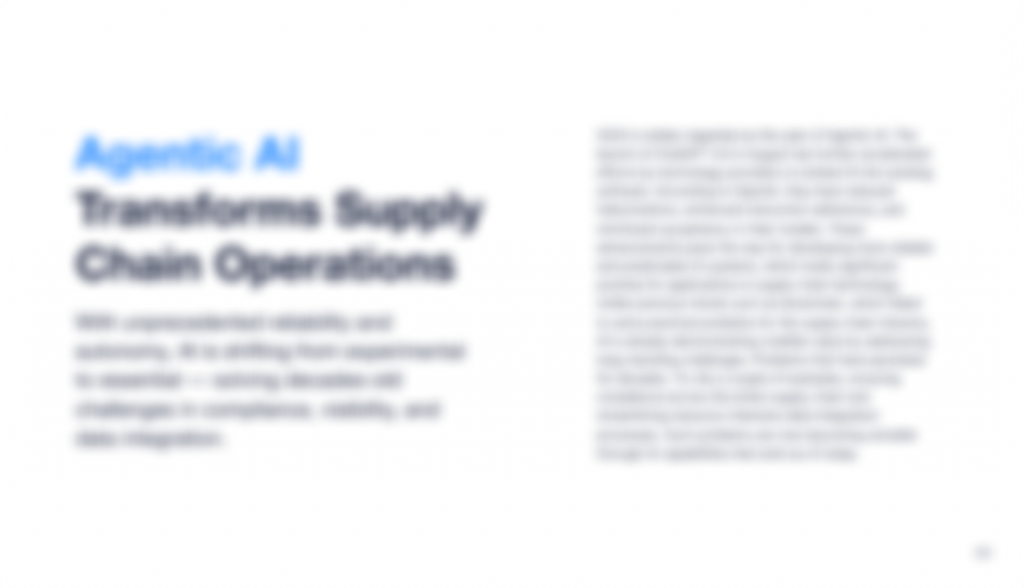
5 Real-World Use Cases: How Agentic AI is Redefining EDI and Logistics
On October 21, 2025 by Latheefa NazeerIntroduction: Agentic AI Transforms EDI and Logistics Workflows
Agentic AI is redefining how modern supply chains operate by turning traditional EDI and logistics processes into intelligent, self-learning systems. With the advancements described in our white paper, “Promise to Practice: Agentic AI in Supply Chain (2025–2026),” AI is moving from being a mere automation tool to an autonomous decision-maker.
For EDI-driven industries, this shift means Natural Language is becoming the new interface, replacing complex UI and SQL queries. Agents are capable of analyzing vast data, making decisions, and orchestrating transactions in real time delivering the unprecedented reliability the supply chain has long needed.
Let’s explore five high-impact, real-world applications where Agentic AI is moving from promise to practice in EDI and logistics operations.
1. End-to-End Automation: Automated Order-to-Cash Flow
The traditional Order-to-Cash (O2C) process is fragmented, often requiring manual checks across ERP, WMS, and finance systems.
Agentic AI enables seamless, end-to-end automation of the O2C cycle by intelligently handling cross-system orchestration. AI agents utilize Tools to access APIs for order validation, inventory checks, shipment scheduling, and invoicing across modules. They learn from historical transaction patterns, predict exceptions before they occur, and trigger actions autonomously to ensure timely order fulfillment. This capability transforms O2C from a reactive workflow into a proactive, adaptive system, drastically improving operational speed and accuracy.
2. Accelerated Integration: Real-Time Partner Onboarding via Auto-Mapping
EDI mapping has been a decades-old bottleneck, often consuming weeks or months to onboard a new trading partner.
Agentic AI solves this by automating cross-system mappings. Leveraging knowledge (like a data field dictionary) and learned patterns from existing integrations, AI agents can auto-create new EDI mapping specifications. They auto-detect a new partner’s EDI requirements, validate connections, and configure the necessary workflows in minutes—not weeks. This capability accelerates business relationship deployment and ensures data accuracy from day one, transforming the tedious process of partner onboarding into a nearly real-time function.
3. Dynamic Decision-Making: Adaptive Routing for Freight Optimization
In logistics, achieving optimal efficiency requires constant, dynamic adaptation to disruptions.
AI agents continuously analyze real-time factors—such as route congestion, carrier performance, fuel prices, and delivery deadlines—fusing data from multiple modules. Using their Models for goal-driven reasoning, they dynamically reroute shipments mid-transit or re-tender loads without human intervention. This multi-module context capability allows agents to not only predict delays but also take immediate, optimal corrective action, significantly reducing transportation costs and improving customer satisfaction through reliable ETAs.
4. Compliance & Accuracy: Smart Document Generation and Processing
Ensuring that transactions adhere to complex business rules and SLAs across a chain of events is critical, yet historically reliant on manual audit.
A key practical application of Agentic AI is the reimagining of compliance monitoring. Business users can define business rule validations and SLA compliance in plain English. The agent converts these into structured outputs and, using its Tools, monitors event chains across different modules. For example, the agent can verify that all SKUs in a Purchase Order EDI are correctly reflected in the Shipment Notification EDI and the final Invoice, ensuring event-chain monitoring and flagging any discrepancy immediately for autonomous remediation.
5. Proactive Visibility: Predictive Exception Management and SLA Compliance.
The best exception management is predictive, not reactive.
Instead of waiting for a shipment to be late or an invoice to fail matching, Agentic AI continuously scans all transaction data for anomalies. By applying predictive logic, agents can identify potential order mismatches, delayed shipments, or failed compliance checks before they escalate into service failures. This capability aligns with the white paper’s vision of AI-generated supply chain simulations by generating and testing scenarios in real-time to maintain business continuity, ensuring your operation moves from managing exceptions to preventing them.
Conclusion: The Future of Autonomous Supply Chain Ecosystems
These are pivotal times, marking a shift toward human-friendly software ecosystems where users converse with systems rather than clicking through them. Agentic AI is not just the next step in automation; it is the realization of the autonomous, predictive supply chain.
The convergence of AI agents, natural language interfaces, and advanced data integration is proving its credible value by enabling: conversational queries, SLA checks, automated mapping, and proactive risk mitigation. This redefines core platforms like ERP, WMS, TMS, and EDI, making them faster, more accurate, and autonomously user-friendly.
Dive deeper into Agentic AI’s impact on supply chains.
[Download our whitepaper “Promise to Practice: Agentic AI in Supply Chain (2025–2026)”]


Leave a Reply